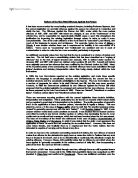The actus Reus of battery is the application of infliction of unlawful force on another person. Battery can be slightest touch as shown by the case of Collins v Wilcock (1984) where two police officers saw two women apparently soliciting for the purpose of prostitution. They asked the defendant to get into the police car for questioning but she refused and walked away. As she was not known to the police, one of the officers walked after her to try to find out her identity. She refused to speak to the officer and again walked away. The officer then took hold of her by the arm to prevent her leaving. She became abusive and scratched the officer’s arm. She was convicted of assaulting a police officer in the execution of his duty, but was acting unlawfully by holding her arm as the officer was not arresting her. The court held that the officer had committed a battery and the defendant was entitled to free herself.
For a battery to be committed the force must be unlawful. Thus a parent who smacks his child, depending on the circumstances of the case, may not be inflicting’ unlawful’ force. This can be seen in A v UK (1998) where a father who had beaten his son with a garden cane, the ECHR ruled that a law allowing force to be used on children offends art 3 of the ECHR. Nevertheless despite this ruling in England if the force is used to correct a child, then this is lawful.
A battery can be through an indirect at which can be seen in Martin (1881) where the defendant placed an iron bar across the doorway of a theatre. He then witched off the lights. In the panic that followed, several of the audience were injured when they were trapped and unable to open the door. We can see that in Martin’s case the defendant did not directly cause injury to the audience but did so via other means. A battery may be committed through a continuing ac as in Fagan v Metropolitan Police Commander (1968) where the defendant parked his car with one of the tyres on a police officer’s foot. When he parked he was unaware that he had done this, but when the police officer asked him to remove it, he refused to do so for several minutes. The court said that at the start there was an act which could be a battery, but the full offence of battery was not committed at that point because there was element of intention. However, it became an offence of battery the moment the intention was formed to leave the wheel on the officer’s foot.
The mens rea for an assault is either an intention to cause another to fear immediate unlawful personal violence, or recklessness as to whether such fear is caused. The mens rea for battery is either an intention to apply unlawful physical force to another or recklessness as whether unlawful force is applied. So intention or recklessness is sufficient for both assault and battery.
Now I am going to discuss Ann’s criminal liability for the injuries to Ben. In this case Ann used unlawful force against Ben as she kicked him in his groin. This can bee seen in A v UK (1998). She also had necessary mens rea because it was reasonably foreseeable that his behaviour or omission would cause the infliction of unlawful force on another person.
ABH is the lowest level of injury under statutory law is referred to as ‘actual body harm’. It is an offence under s47 of the offence against the person act 1861. for the actus reus to be establish It is necessary to prove that there was an assault or battery and that caused actual bodily harm. In Miller (1954) it was said that actual bodily harm is ‘any hurt or injury calculated to interfere with the health or comfort of the victim. Section 47 can be charged where there is any injury. Bruising, grazes and scratches all come with this. Psychiatric injury also classed as ‘actual bodily harm’. In the case of Ann, injuries to Ben were more severe than assault and battery as he lost the sight in one eye.
there is no additional mens rea requirement for that of Actual bodily harm thus the mens rea for common assault will suffice and althoughtABH is more serios offence, recklessness will suffice, and provide that there is a risk involved it need not to be a serious risk. R v Savage (1991) where a women in a pub threw beer over another woman. in doing this the glass slipped from defendant's hand and the victim's hand was cut by glass. the defendant said that she had only intended to throw beer over her victim. she had not intended her to be injured, nor had realised that there was a risk of injury. held in the HL: the fact that she had intended to throw beer over the women meant that she had intend to apply unlawful force.
in the case of Ann and Ben, which is quite similar to the case of R v Savage, Ann did intended some harm to her victim as she tried to punch him but it cant be Actual Bodily Harm because the injuries to Ben were more severe then ABH so now i am going to look at GBH S20 to find out Ann's Criminal liability.








